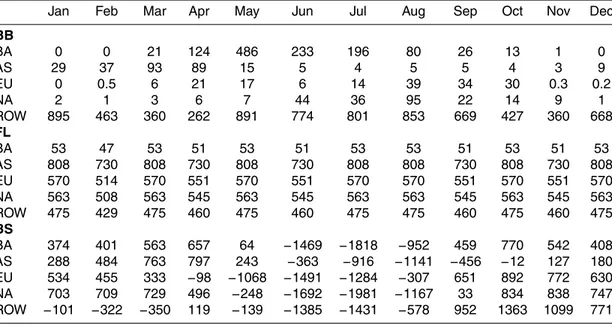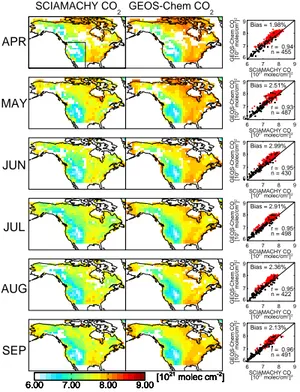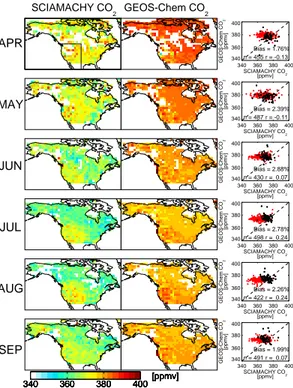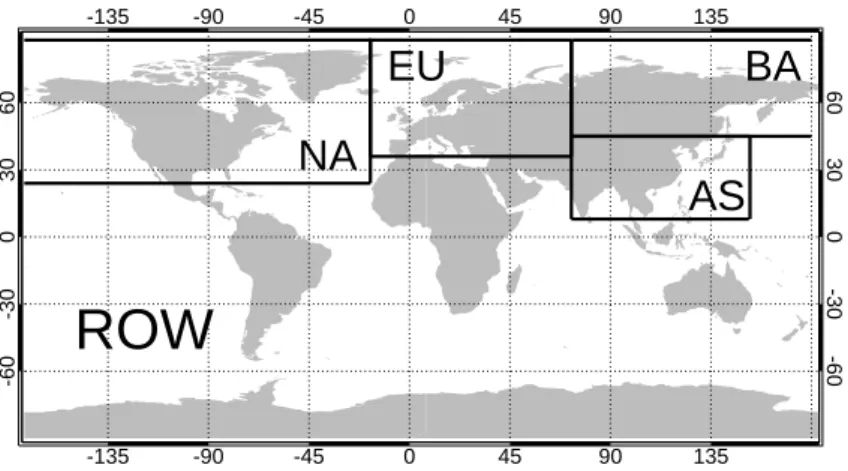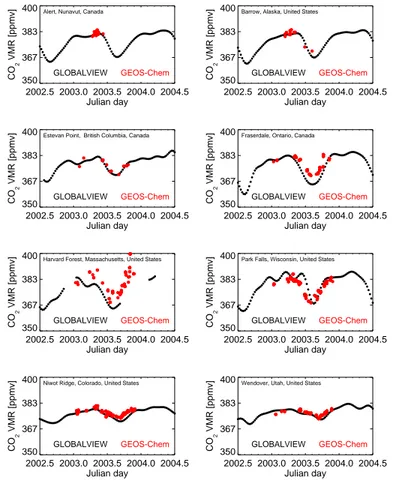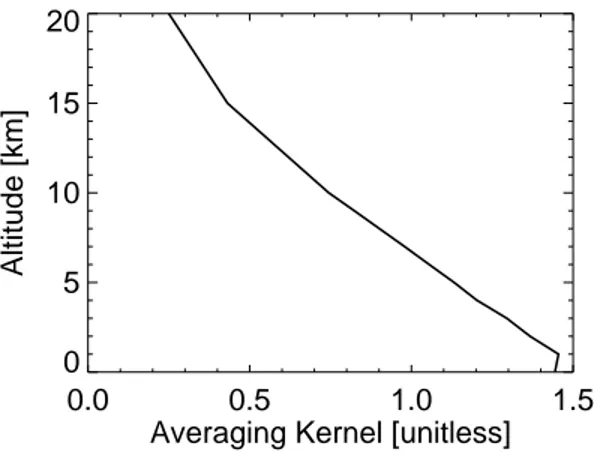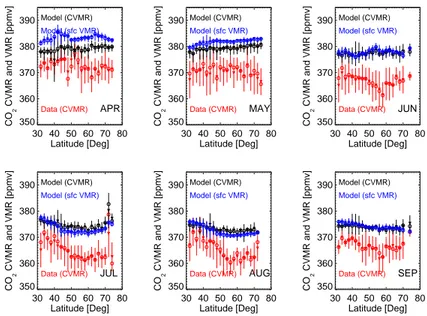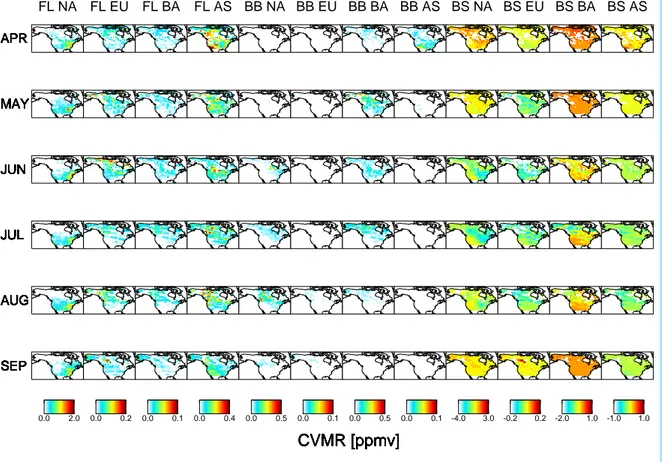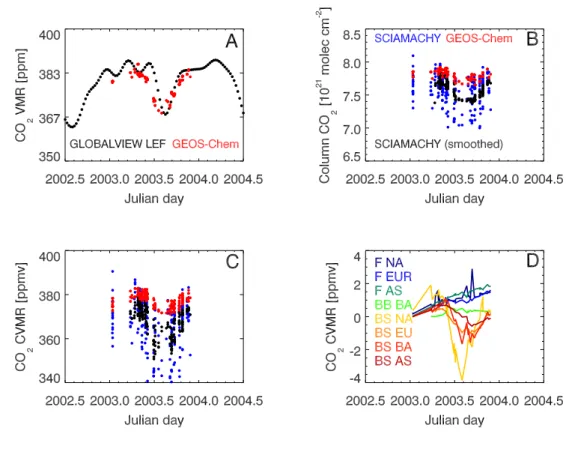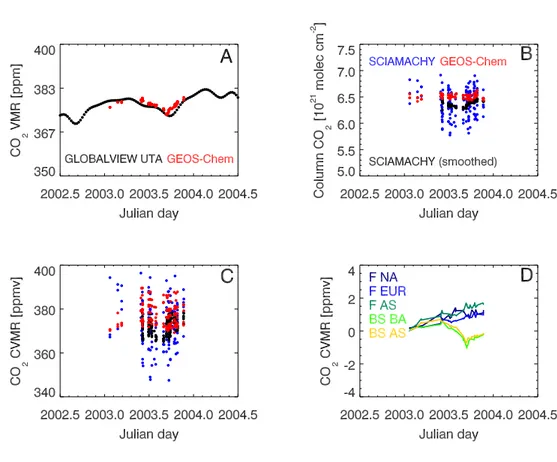ACPD
8, 7339–7371, 2008Interpreting column CO2 Data
P. I. Palmer et al.
Title Page
Abstract Introduction
Conclusions References
Tables Figures
◭ ◮
◭ ◮
Back Close
Full Screen / Esc
Printer-friendly Version
Interactive Discussion
Atmos. Chem. Phys. Discuss., 8, 7339–7371, 2008 www.atmos-chem-phys-discuss.net/8/7339/2008/ © Author(s) 2008. This work is distributed under the Creative Commons Attribution 3.0 License.
Atmospheric Chemistry and Physics Discussions
Interpreting the variability of CO
2
columns
over North America using a chemistry
transport model: application to
SCIAMACHY data
P. I. Palmer1, M. P. Barkley1, and P. S. Monks2
1
School of GeoSciences, University of Edinburgh, UK 2
Department of Chemistry, University of Leicester, UK
Received: 18 February 2008 – Accepted: 25 March 2008 – Published: 16 April 2008
Correspondence to: P. I. Palmer (pip@ed.ac.uk)
ACPD
8, 7339–7371, 2008Interpreting column CO2 Data
P. I. Palmer et al.
Title Page
Abstract Introduction
Conclusions References
Tables Figures
◭ ◮
◭ ◮
Back Close
Full Screen / Esc
Printer-friendly Version
Interactive Discussion Abstract
We use the GEOS-Chem chemistry transport model to interpret variability of CO2
columns and associated column-averaged volume mixing ratios (CVMRs) observed by the SCIAMACHY satellite instrument during the 2003 North American growing sea-son, accounting for the instrument averaging kernel. Model and observed columns,
5
largely determined by surface topography, averaged on a 2◦×2.5◦grid, are in excellent
agreement (model bias=3%, r >0.9), as expected. Model and observed CVMRs,
de-termined by scaling column CO2by surface pressure data, are on average within 3%
but are only weakly correlated, reflecting a large positive model bias (10–15 ppmv) at
50–70◦N during midsummer at the peak of biospheric uptake. GEOS-Chem generally
10
reproduces the magnitude and seasonal cycle of observed CO2surface VMRs across
North America. During midsummer we find that model CVMRs and surface VMRs converge, reflecting the instrument vertical sensitivity and the strong influence of the
land biosphere on lower tropospheric CO2 columns. We use model tagged tracers to
show that local fluxes largely determine CVMR variability over North America, with the
15
largest individual CVMR contributions (1.1%) from the land biosphere. Fuel sources are relatively constant while biomass burning make a significant contribution only dur-ing midsummer. We also show that non-local sources contribute significantly to total CVMRs over North America, with the boreal Asian land biosphere contributing close to 1% in midsummer at high latitudes. We used the monthly-mean Jacobian matrix for
20
ACPD
8, 7339–7371, 2008Interpreting column CO2 Data
P. I. Palmer et al.
Title Page
Abstract Introduction
Conclusions References
Tables Figures
◭ ◮
◭ ◮
Back Close
Full Screen / Esc
Printer-friendly Version
Interactive Discussion 1 Introduction
The importance of the natural carbon cycle in understanding climate is well established (IPCC,2007). A better quantitative understanding of natural sources and sinks of car-bon dioxide (CO2), in particular, is crucial if CO2mitigation and sequestration activities relying on these natural fluxes are to work effectively. Estimation of sources and sinks
5
of CO2using inverted atmospheric transport models to interpret atmospheric concen-tration data has been generally effective but has had varied success in the tropics where there is relatively little data (Gurney et al., 2002). Previous inversion studies have used surface concentration data (Bousquet et al.,1999), representative of spa-tial scales of the order of 1000 km by virtue of their location; aircraft concentration data
10
(Palmer et al.,2006;Stephens et al.,2007) representative of spatial scales of the order of 10–100 s km, and generally only available during intensive campaign periods; and concentrations from tall towers (Chen et al.,2007), representative of spatial scales of the order of<1–10 s km.
New CO2 column data from low-Earth orbit space-borne sensors (e.g., the
Scan-15
ning Imaging Absorption Spectrometer for Atmospheric Chartography (SCIAMACHY) (Bovensmann et al.,1999), the Orbiting Carbon Observatory (OCO) (Crisp et al.,2004;
Miller et al., 2007), and the Greenhouse Observating SATellite (GOSAT) (Hamazaki
et al.,2004)), measuring in the near-infrared (NIR), are sensitive to changes in CO2in the lower troposphere and therefore provide potentially useful data with which to
esti-20
mate surface fluxes of CO2 (Chevallier et al.,2007). One of the main advantages of space-borne sensors is their repeated global coverage, facilitating measurements, for example, over remote tropical ecosystems that are currently poorly characterized by in situ data. SCIAMACHY CO2data, in particular, are representative of a 60 km×30 km spatial footprint, comparable with the horizontal resolution of current generation
atmo-25
spheric transport models; upcoming instruments will have better horizontal resolution. At the time of writing, SCIAMACHY is the only space-borne sensor in orbit that
ACPD
8, 7339–7371, 2008Interpreting column CO2 Data
P. I. Palmer et al.
Title Page
Abstract Introduction
Conclusions References
Tables Figures
◭ ◮
◭ ◮
Back Close
Full Screen / Esc
Printer-friendly Version
Interactive Discussion
few model studies of SCIAMACHY CO2column data, which have provided only
qualita-tive comparisons (Buchwitz et al., 2005, 2007;Barkley et al.,2006c). In this paper, we use the GEOS-Chem global 3-D chemistry transport model (CTM) to interpret the
vari-ability in CO2columns from SCIAMACHY over North America during the 2003 growing
season. We focus on North America because of the extensive multi-platform
measure-5
ment programme which can be used to help evaluate SCIAMACHY via the CTM. A number of studies have illustrated that the precision and accuracy of measured CO2 columns is critical to their success in better quantifying the carbon cycle. The temporal and spatial variations in column data are much less than those in surface
concentration measurements (Olsen and Randerson, 2004). Inversions of synthetic
10
data have shown that CO2 columns have to be retrieved with a precision of less than 1% over a 8◦×10◦ grid if they are to improve upon the existing ground-based network used for source/sink estimation (Rayner and O’Brien,2001). Consequently, unchar-acterized systematic biases will compromise this ability (Miller et al., 2007). Use of column CO2has the benefit of effectively reducing the potential model bias introduced
15
by inaccurate descriptions of vertical mixing (Olsen and Randerson,2004). Nonethe-less, recent work has highlighted the requirement of using accurate, synoptic-scale atmospheric transport to interpret CO2 column data in order to minimize errors asso-ciated with spatial sampling, particularly over geographical regions with active weather systems (Corbin et al., 2008). The vertically integrated CO2 column abundance
rep-20
resents the sum of an age-spectrum of airmasses. Young airmasses (defined in this paper as<3 months), still bearing the signatures of surface fluxes, are subject to at-mospheric dilution processes that eventually render these signatures indistinguishable from the global background whose variability is determined by atmospheric transport. In this paper we show that variability in space-borne CO2 columns over one region is
25
ACPD
8, 7339–7371, 2008Interpreting column CO2 Data
P. I. Palmer et al.
Title Page
Abstract Introduction
Conclusions References
Tables Figures
◭ ◮
◭ ◮
Back Close
Full Screen / Esc
Printer-friendly Version
Interactive Discussion
the satellite instrument can, in some instances, enhance surface flux signatures. Section2briefly describes the SCIAMACHY retrievals of CO2used in this work and
presents CO2distributions over North America. Section3describes the GEOS-Chem
CTM used for this study and presents a brief model evaluation using surface CO2
data over North America from the GLOBALVIEW network (GLOBALVIEW-CO2,2006).
5
Section4 critically examines the comparison between model and SCIAMACHY CO2
columns and CVMRs. In Sect. 5 we use the model to estimate which land-based
fluxes determine the continental-scale variability of CVMRs over North America during the growing season, and look in detail at two contrasting sites over North America. In
Sect.6 we discuss how CVMRs data could be used to infer source and sink
distribu-10
tions. We conclude the paper in Sect. 5.
2 SCIAMACHY CO2data
SCIAMACHY is a nadir and limb-viewing UV/Vis/NIR solar backscatter instrument aboard the ENVISAT satellite, launched in 2002 (Bovensmann et al., 1999). It mea-sures from 240 to 2380 nm, with a resolution of 0.2–1.4 nm depending on the channel.
15
ENVISAT is in a near-polar sun-synchronous orbit crossing the equator at about 10:00 local solar time in the descending node, achieving full longitudinal global coverage at the equator within six days. SCIAMACHY makes measurements in an alternating nadir and limb sequence. We use the nadir measurements that have a horizontal resolution of 60×30 km2(across×along track).
20
We include here only a short description of the retrieval of SCIAMACHY CO2
and refer the reader to dedicated retrieval studies (Buchwitz et al., 2000; Barkley
et al.,2006a). CO2columns are retrieved in the 1561.03–1585.39 nm wavelength win-dow using the Full Spectral Initiation (FSI) (Barkley et al., 2006a) Weighting
Func-tion Modified Differential Optical Absorption Spectroscopy (WFM-DOAS) (Buchwitz
25
ACPD
8, 7339–7371, 2008Interpreting column CO2 Data
P. I. Palmer et al.
Title Page
Abstract Introduction
Conclusions References
Tables Figures
◭ ◮
◭ ◮
Back Close
Full Screen / Esc
Printer-friendly Version
Interactive Discussion
attributable to poor characterization of the atmospheric state (e.g., aerosols, cirrus
clouds) (Barkley et al.,2006a). Cloudy scenes are diagnosed using the SCIAMACHY
polarization measurement devices using a cloud algorithm developed byKrijger et al.
(2005), as described by Barkley et al.(2006a), and excluded from subsequent analy-ses. We also exclude back scans, observations with solar zenith angles>75◦(Barkley
5
et al.,2006a), and observations over ocean due to very low surface albedo. We use
only observations with a retrieval error of<5% and within a range of 340–400 ppmv (to adequately constrain the light path). Previous studies have extensively evaluated FSI
CO2 data against independent measurements over the Northern Hemisphere.
Com-parisons between SCIAMACHY CO2and ground-based Fourier Transform
Spectrom-10
eters (FTS) and a CTM show a negative bias of 2–4% in the absolute CVMRs
mag-nitudes. Strong correlations between SCIAMACHY CO2 anomalies and aircraft and
ground-based data imply that SCIAMACHY can track lower troposphere variability on at least monthly timescales, and has the potential to monitor changes in CO2 (Barkley et al., 2006b, c, 2007). At this time, several retrieval issues (e.g., aerosol
contamina-15
tion) need to be resolved before the data are characterized sufficiently well for inverse modelling.
Figure1shows monthly mean CO2columns (molec cm
−2
) over North America dur-ing the 2003 growdur-ing season (here defined as April–September) averaged over the GEOS-Chem 2◦×2.5◦ grid (Sect.3). Observed columns represent the vertical integral
20
of atmospheric CO2 weighted by the instrument averaging kernel that describes the
instrument sensitivity to changes in the vertical profile of CO2. As we show later in
Sect. 3 SCIAMACHY has most sensitivity to CO2 in the lower troposphere (Barkley
et al.,2006c). The average number of individual scenes that fall into a North American 2◦×2.5◦ grid box is between 25 and 50, depending on month; this effectively reduces
25
gener-ACPD
8, 7339–7371, 2008Interpreting column CO2 Data
P. I. Palmer et al.
Title Page
Abstract Introduction
Conclusions References
Tables Figures
◭ ◮
◭ ◮
Back Close
Full Screen / Esc
Printer-friendly Version
Interactive Discussion
ally later in the summer. The spatial distribution of CO2columns is determined largely by surface topography, with the Rockies mountain range introducing an apparent lon-gitudinal gradient across North America.
To remove artefacts introduced by surface elevation we normalize retrieved CO2
columns using the nearest 6-hourly 1.125◦×1.125◦ ECMWF model surface pressure
5
(Barkley et al., 2006c) to derive a CVMR. As we discuss in Sect. 4 there is signif-icantly less agreement between model and observed values of CVMR than column
abundances. Figure 2 shows monthly mean SCIAMACHY CO2 CVMRs from April
to September 2003 over North America. Values range from 350 to 390 ppmv with a 15–20 ppmv peak-to-peak seasonal cycle over regions with a strong biospheric
sig-10
nal, consistent with previous studies (Olsen and Randerson,2004). Other studies of
SCIAMACHY CO2data have used O2columns to normalize retrieved CO2columns, to
derive a dry air CVMR, (Buchwitz et al.,2007). Using O2instead of surface pressure will partially cancel effects of aerosols and clouds on the light path. However, at the time of writing the general efficacy of this approach is not well quantified owing to
dif-15
ferences between the radiative transfer and subsequent averaging kernels of the CO2 and O2spectral fitting windows. Future satellite missions (e.g., OCO and GOSAT) also plan to use O2to normalize derived CO2columns.
3 The GEOS-Chem forward model of CO2: description and evaluation
We use the GEOS-Chem global 3-D chemistry transport model (v7-03-06) to calculate
20
column concentrations of CO2 from prescribed surface CO2 fluxes described in this
section. We used the model with a horizontal resolution of 2◦×2.5◦, with 30 vertical
levels (derived from the native 48 levels) ranging from the surface to the mesosphere, 20 of which are below 12 km. The model is driven by GEOS-4 assimilated meteorology data from the Global Modeling and Assimilation Office Global Circulation Model based
25
at NASA Goddard. The 3-D meteorological data is updated every six hours, and the
ACPD
8, 7339–7371, 2008Interpreting column CO2 Data
P. I. Palmer et al.
Title Page
Abstract Introduction
Conclusions References
Tables Figures
◭ ◮
◭ ◮
Back Close
Full Screen / Esc
Printer-friendly Version
Interactive Discussion
is based onSuntharalingam et al.(2004) andPalmer et al.(2006); here, we provide a description of modifications to these previous studies.
3.1 CO2flux inventories
Table1reports the regional monthly mean estimates of CO2fluxes from fuel combus-tion (sum of fossil fuel and biofuel), biomass burning, and the land biosphere used
5
in GEOS-Chem. Gridded fossil fuel emission distributions are representative of 1995 (Suntharalingam et al.,2004) which we have scaled to 2003 values using regional bud-get estimates for the top 20 emitting countries in 2003 from the Carbon Dioxide Informa-tion Analysis Center (Marland et al.,2007), including sources from fossil fuel burning, gas flaring, and cement production. On a global scale the sum of these sources has
in-10
creased by 14% relative to 1995 values. Biofuel emission estimates, taken fromYevich
and Logan (2003), represent climatological values. This source of CO2 is generally less than 1% of the total fuel source for North America and western Europe but repre-sents up to 18% of the total fuel source for Asia. In many regions, particularly Asia, the distributions of fossil and bio-fuel emissions overlap significantly so we lump these fuel
15
source together (FL). Monthly biomass burning (BB) emission estimates are taken from
the second version of the Global Fire Emission Database (GFEDv2) for 2003 (van der
Werf et al.,2006). These data are derived from ground-based and satellite observa-tions and should describe well the burning distribuobserva-tions. Monthly mean air-sea fluxes of CO2are taken fromTakahashi et al.(1999). As we show later the observed variability
20
in SCIAMACHY data is determined largely by continental fluxes so we do not discuss further the role of ocean exchange in this study. We use daily mean land biosphere (BS) fluxes from the CASA model for 2001 (Randerson et al.,1997), in the absence of corresponding fluxes for 2003. Year-to-year variability of CASA monthly mean land biosphere CO2fluxes is small (<10%) so our approach should not introduce significant
25
ACPD
8, 7339–7371, 2008Interpreting column CO2 Data
P. I. Palmer et al.
Title Page
Abstract Introduction
Conclusions References
Tables Figures
◭ ◮
◭ ◮
Back Close
Full Screen / Esc
Printer-friendly Version
Interactive Discussion
3.2 Model initialization
CO2 concentrations for January 2002 were initialized from a previously evaluated
model run (Palmer et al., 2006), which we integrate forward to January 2003. We
include an additional intialization to correction for the model bias introduced by not
accounting for the net uptake of CO2 from the terrestrial biosphere. We make this
5
downward correct by comparing the difference between GLOBALVIEW CO2 data
(GLOBALVIEW-CO2,2006) and model concentrations over the Pacific during January 2003. Differences range from 1 to 4 ppmv with a median of 3.5 ppmv, and we subtract this value globally, followingSuntharalingam et al.(2004).
From January 2003 the total CO2 tracer becomes the “background” CO2
concen-10
tration and is only subject to atmospheric transport. At that time, we also introduce additional model tracers, initialized with a uniform value (for numerical reasons and which is subtracted in subsequent analyses), that account for the monthly production and loss of CO2originating from specific geographical regions and surface processes. The linear sum of these monthly tagged tracers (and the “background”) is equivalent
15
to the total CO2. Figure 3 shows the tagged geographical regions for these experi-ments: North America (NA), Europe (EU), Asia (AS), Boreal Asia (BA), and the rest of the World (ROW). We separately account for CO2 contributions from fossil fuel emis-sions (FF), biofuel emisemis-sions (BF), biomass burning (BB), the land biosphere (BS), the ocean biosphere (OC), and the inert initial conditions from January 2003. As
men-20
tioned above, FL describes the sum of FF and BF. We find the ocean flux contribution to atmospheric CO2columns is diffuse and is difficult to distinguish from the initial con-ditions and is consequently lumped with the ROW.
3.3 Evaluation of model North American surface CO2concentrations
Figure 4 presents a comparison of model and GLOBALVIEW measurements
25
ACPD
8, 7339–7371, 2008Interpreting column CO2 Data
P. I. Palmer et al.
Title Page
Abstract Introduction
Conclusions References
Tables Figures
◭ ◮
◭ ◮
Back Close
Full Screen / Esc
Printer-friendly Version
Interactive Discussion
in 2003 and that have contrasting seasonal cycles. We sample the model at the lo-cation of each measurement site and at the time that SCIAMACHY passes over each site, to illustrate the extent to which SCIAMACHY can observe the seasonal cycle over North America. For example, there is no data in early 2003 over Canada because of persistent cloud. In general, the 2◦×2.5◦model has some skill in reproducing the in situ
5
surface concentration data but there are some notable exceptions where the model
overestimates observed concentrations by nearly 10 ppmv during periods of CO2
up-take (Fraserdale and Harvard Forest) and mistimes the land biosphere upup-take by a few weeks (Park Falls). As we show later in Sect.4these examples of model error are not necessarily explained only by local North American fluxes but also by other continental
10
fluxes.
3.4 Modelling CO2columns and CVMRs from SCIAMACHY
Global 3-D model CO2distributions are sampled at the time and location of the
SCIA-MACHY scenes. We take into account the vertical sensitivity of SCIAMACHY to
changes in CO2 by using the instrument averaging kernel, A. The averaging kernel
15
formally describes the sensitivity of retrieved CO2columns to changes in CO2 through-out the column, and is a reflection of atmospheric radiative transfer at NIR wavelengths.
Figure5 shows the mean SCIAMACHY averaging kernel, averaged over solar zenith
angles ranging from 0◦ to 70◦, increase in sensitivity throughout the troposphere with only a small fall-offin the last 1 km (Barkley et al.,2006c). As noted above, not taking
20
Ainto account compromises subsequent interpretation of observed columns. Model
SCIAMACHY CO2columns,Ω, are given by (Rodgers,2000)
Ω = Ωa+a(H(x)−xa), (1)
whereH(x) is the GEOS-Chem forward model, xa is the a priori CO2 concentration
profile taken from climatology and also used in the SCIAMACHY retrievals (Remedios
25
ACPD
8, 7339–7371, 2008Interpreting column CO2 Data
P. I. Palmer et al.
Title Page
Abstract Introduction
Conclusions References
Tables Figures
◭ ◮
◭ ◮
Back Close
Full Screen / Esc
Printer-friendly Version
Interactive Discussion
bytTA, wheret is the column integration operator that integrates a vertical profile to a column and the superscript T denotes the matrix transpose operation.
The tagged column contributions to the total CO2 columns, corresponding to
geo-graphical regions in Fig.3and source types discussed above, are calculated by weight-ing the model vertical profile by the column averagweight-ing kernel:Ωtag=a[H(x)]tag.
5
Model CO2 CVMRs are determined by scaling each model column by its nearest
GEOS-4 surface pressure value, taking into account unit changes. We used 1◦×1.125◦ GEOS-4 surface pressure data to be consistent with a) the horizontal resolution of the
ECWMF surface pressure data used in the SCIAMACHY retrieval, and b) the 2◦×2.5◦
GEOS-4 meteorology used in the GEOS-Chem model.
10
4 Comparison of model and observed CO2columns and CVMRs
Figure1 shows model CO2 columns (molec cm
−2
) are generally within 3% of the ob-served columns, consistent with (Barkley et al.,2006c), and describe more than 80% of the observed variability. As discussed earlier, column distributions are largely deter-mined by changes in surface topography, and consequently a reflection of the surface
15
pressure fields. However, it is clear that model and observed columns show the largest disagreement over the North and East during periods of biospheric uptake (denoted by red data in the Fig.1scatterplot). Model bias, used throughout this paper, is defined as:
bias=1001 n
n
X
i=1
Ωmi −Ω
o i
max(Ωmi ,Ω o i)
, (2)
20
whereΩo is the observed column, Ωm is the model column, and nis the number of
observations.
Figure2shows the model and observed CVMRs (ppmv). Observed CVMRs
ACPD
8, 7339–7371, 2008Interpreting column CO2 Data
P. I. Palmer et al.
Title Page
Abstract Introduction
Conclusions References
Tables Figures
◭ ◮
◭ ◮
Back Close
Full Screen / Esc
Printer-friendly Version
Interactive Discussion
CVMRs generally have a narrower dynamic range compared with the observations,
largely confined between 360 to 390 ppmv. Differences between model and observed
CVMRs during each month is approximately Gaussian centred away from zero (not shown). Unlike SCIAMACHY CO we find no significant correlation between model and data differences and the spectral fitting uncertainty (de Laat et al.,2007) . On average
5
the model is within 3% of the observed CVMRs, but this reflects a large positive bias of low observed CVMRs and small negative bias of high observed columns. The large positive bias is largely due to the model underestimating columns over the eastern US and at higher latitudes (denoted by red data points in Fig.2scatterplot), where vegeta-tion is predominant, but will also include an unquantified component from measurement
10
uncertainty. On a continental scale, the model has relatively little skill in reproducing SCIAMACHY CVMRs, capturing only a few percent of the observed variability, which is determined mainly by the dipole in CO2column oriented NW-SE, characteristic of the seasonal biospheric uptake (Barkley et al., 2006b, c;Buchwitz et al.,2007). However,
as we show in Sect.4the model does have skill in reproducing SCIAMACHY data at
15
individual GLOBALVIEW stations.
Figure 6 shows the North American model and SCIAMACHY CO2 CVMRs and
model surface VMRs expressed as a zonal mean. The zonal mean removes much of the valuable spatial structure but 1) highlights the zonal mean bias between the model
and SCIAMACHY, and 2) reveals the dramatic 10 ppmv decrease in SCIAMACHY CO2
20
CVMR during the mid-summer months at latitudes between 50 to 70◦N. The
corre-sponding decrease in model CVMR is only 5 ppmv. We also note that during
mid-summer when the biospheric uptake of CO2peaks the model CVMR and surface CO2
concentrations converge, reflecting the increasing influence of land biosphere on the lower tropospheric column. This implies that that measured columns will be most
sen-25
sitive to surface processes during mid-summer when biospheric uptake is at its peak,
which has implications for surface flux estimation. Previous studies of CO2 column
ACPD
8, 7339–7371, 2008Interpreting column CO2 Data
P. I. Palmer et al.
Title Page
Abstract Introduction
Conclusions References
Tables Figures
◭ ◮
◭ ◮
Back Close
Full Screen / Esc
Printer-friendly Version
Interactive Discussion
later, outside of the peak North American growing period other CO2sources and sinks play a comparable role in determining the column distribution.
5 What surface fluxes determine model CO2CVMR variability over North
Amer-ica?
5.1 Continental-scale distributions
5
Figure7shows the land-based contributions to CO2CVMRs over North America (Fig.3
and Table1). Many source and sink terms show large seasonal cycles in their CVMR
contributions. Background CO2CVMRs (January 2003 initial conditions in our calcula-tions, Sect.3) are typically greater than 350 ppmv (not shown).
CO2columns over North America are determined largely by local sources and sinks,
10
as expected. The North American land biosphere (BS NA) represents the single largest
contribution to total CO2, with a minimum and maximum of−8 ppmv and 3 ppmv,
re-spectively, corresponding to a maximum of 1.1% of the total column. This contribution, here determined by the CASA model (Sect.3), is a source of CO2until late May, after which it becomes a sink peaking in July. During periods of uptake it is characterized by
15
a dipole with uptake over the North and East and a source over the arid southwestern statesBarkley et al.(2006b, c). A similar pattern is evident in model and observed total
columns and CVMRs (Figs.1 and 2). Fuel sources from North America (FL NA) are
relatively constant in magnitude throughout the year (Table1), with the largest CVMR contributions over the East coast (up to 0.5 ppmv). The North American biomass
burn-20
ing (BB NA) season starts in Canada in June reaching a peak in August with partial monthly mean columns of 1 ppmv; this contribution, in particular, is likely to be much larger on sub-monthly timescales and finer spatial scales.
We also show that CO2 columns over North America are significantly influenced
by Boreal Asia and mainland Asia and that in some months these column
contribu-25
ACPD
8, 7339–7371, 2008Interpreting column CO2 Data
P. I. Palmer et al.
Title Page
Abstract Introduction
Conclusions References
Tables Figures
◭ ◮
◭ ◮
Back Close
Full Screen / Esc
Printer-friendly Version
Interactive Discussion
from Boreal Asian fuel sources (FL BA) are largest over Alaska and northern Canada, reflecting the latitude of Boreal Asia and subsequent atmospheric transport. Similar spatial distributions are shown for biomass burning and the land-biosphere from Bo-real Asia (BS BA), with the contribution from biomass burning peaking in mid-summer. The land-biosphere is most positive during April (1.2 ppmv) and is most negative during
5
July (−5 ppmv). The seasonal cycle of BS BA is similar to that of the North American biosphere (BS NA), which may compromise the ability of column observations to in-dependently estimate fluxes from the North American and Boreal Asian biospheres despite exhibiting different spatial distribution in column space. The largest mainland
Asian fuel and biomass burning contributions (FL AS, BB AS) to North American CO2
10
occur in March (not shown) and April over the west Coast, consistent with current un-derstanding of the temporal continental outflow from that region (Liu et al.,2003). The biospheric signal from mainland Asia (BS AS) is delayed relative to North America with a negative peak in August. European column contributions from fuel, biomass burn-ing, and the land biosphere (FL EU, BB EU, BS EU) are qualititively similar to Boreal
15
Asia, reflecting similar high latitude atmospheric transport, but they are an order of magnitude smaller.
Many of these sources and sinks will be much higher on sub-monthly temporal scales and on finer spatial scales but our results reiterate previous studies that emphasize the importance of sub-1% precision column measurements if physically meaningful surface
20
flux distributions of CO2are to be estimated.
5.2 Temporal distributions at individual sites
Figures 8 and 9 show the CO2 flux signatures that determine the variability of CO2 at two measurement sites: the WLEF television tower, 12 km east of Park Falls in
Wisconsin and Wendover in Utah. Earlier, in Fig.4, we showed that GEOS-Chem had
25
some skill in reproducing the seasonal cycle of CO2at both these sites, but predicted
premature uptake of CO2 at the Parks Falls site. We chose these two sites for this
ACPD
8, 7339–7371, 2008Interpreting column CO2 Data
P. I. Palmer et al.
Title Page
Abstract Introduction
Conclusions References
Tables Figures
◭ ◮
◭ ◮
Back Close
Full Screen / Esc
Printer-friendly Version
Interactive Discussion
As in Fig.4we sample the model at the location of the two ground-based sites and at the SCIAMACHY overpass time when data is available. The WLEF site shows a sea-sonal cycle with a peak-to-peak range of 20 ppmv, which is captured reasonably well
by GEOS-Chem. The corresponding model CO2columns vary by 3×10
20
molec cm−2, representing a change of order 4% in the column. SCIAMACHY reproduces the
broad-5
scale seasonal cycle observed at the surface (and the tower data at this site (Barkley
et al.,2007)) but because of noise, due to the retrieval and the relatively coarse spatial colocation (Barkley et al.,2007), it is difficult to assess whether SCIAMACHY repro-duces the later onset of the uptake observed by surface measurements. We use a
30-point running mean to effectively reduce random noise. The resulting smoothed
10
observed columns, even after accounting for the bias, show a larger drawdown of CO2 during midsummer. Model and observed CVMRs show greater discrepancy during midsummer months. Figure8d shows the seasonal contributions of different monthly
sources and sinks to model CVMRs >0.5 ppmv at some time during the year. Fuel
combustion from North America, Europe and mainland Asia increase throughout the
15
year, as expected, with a mean gradient of 1.5 ppmv/year. The North American bio-sphere at this site makes a significant contribution to the total CO2CVMR, with smaller but significant contributions from Boreal Asia, Europe and mainland Asia. The different continental biosphere signals peak at different times, due to differences in seasonal cy-cles and atmospheric transport. Biomass burning from Boreal Asia plays only a small
20
role in determining CO2CVMRs at this site, peaking in the Spring. Based on this cal-culation it is difficult to attribute differences between model and observed CO2CMVRs to bias in the magnitude or timing of different continental biosphere fluxes. However, as we discuss in the next section these subtle differences may help to spatially disagre-gate CO2fluxes using formal inverse models.
25
Figure9shows model and observed columns and CVMRs at Wendover, Utah. The
gen-ACPD
8, 7339–7371, 2008Interpreting column CO2 Data
P. I. Palmer et al.
Title Page
Abstract Introduction
Conclusions References
Tables Figures
◭ ◮
◭ ◮
Back Close
Full Screen / Esc
Printer-friendly Version
Interactive Discussion
erally much noisier than at WLEF, reflecting rapid variations in relatively small values of GEOS-4 surface pressure (790–840 hPa compared with 960–990 hPa at WLEF).
Apparent drawdown of observed and model CO2 columns and CVMRs at this site is
much weaker than at the WLEF site. Figure9d shows the seasonal contributions of
different monthly sources and sinks to model CVMRs >0.5 ppmv at some time during
5
the year. As at WLEF there is a strong fuel signature originating from North America, Europe, and mainland Asia with a similar gradient through the year. From our analysis the weak seasonal cycle is determined by biospheric signals from Boreal and mainland Asia, which is not obvious from interpreting total column data.
6 Implications for surface flux estimation
10
The ultimate goal of space-borne CO2data are to locate and quantify natural sources and sinks of CO2so that more detailed studies can assess their durability with changes in climate. Generally, an inverse model is required for that purpose. While such a study is outside the scope of this paper, and will be the subject of forthcoming work, we calculate the monthly mean Jacobian matrix corresponding to our forward model
cal-15
culations to illustrate the ability of these column data to infer individual sources and sinks of CO2. In general the Jacobian matrix, describing the sensitivity of total CO2 columns to changes in surface sources and sinks, attributes differences between for-ward model (GEOS-Chem) and observed quantities to specific surface sources and sinks.
20
For illustration only, Fig.10shows the monthly mean columns of the Jacobian matrix for North America, based on Fig.7and Table1. These calculations show that the North America and Boreal Asia land biosphere signals are among the strongest signals that can potentially be retrieved independently. While the initial goal of inversions of space-based CO2data may be to estimate total fluxes on a continental scale, it is clear that
25
ACPD
8, 7339–7371, 2008Interpreting column CO2 Data
P. I. Palmer et al.
Title Page
Abstract Introduction
Conclusions References
Tables Figures
◭ ◮
◭ ◮
Back Close
Full Screen / Esc
Printer-friendly Version
Interactive Discussion
earlier and show in Fig.7the distributions of many of the dominant flux signatures are sufficiently separated in space and time to permit independent estimation of individual fluxes; this needs to be confirmed with inversion calculations. Many of the sources and sink of CO2shown here will have much stronger signatures on finer temporal and spatial scales and that should also be considered.
5
The e-folding lifetime of these individual flux contributions is typically 3 to 4 months, with e-folding lifetimes exceeding 6 months for Asian sources, consistent withBruhwiler
et al. (2005). All sensitivities converge to a background sensitivity (20) beyond which individual source and sink signatures are well mixed. In practice, the inversion will use a Jacobian matrix for a specific surface grid box to avoid aliasing and to capture the
10
sharp temporal gradients in CO2during the onset and decline of the growing season.
7 Conclusions
We have used the GEOS-Chem global 3-D CTM, driven by a priori sources and sinks of
CO2, to interpret variability of SCIAMACHY CO2columns. We have shown that
GEOS-Chem has some skill in reproducing observed distributions of surface VMR at sites over
15
North America. The magnitude and distribution of model CO2columns, accounting for
the SCIAMACHY averaging kernel, are determined largely by surface pressure and
show good agreement with SCIAMACHY (r=0.9) as expected but with a 3% positive
bias. Model CO2 CVMRs show much less agreement, partly driven by a large positive
bias in drawdown of CO2 during the growing season. We show that model CVMRs
20
and surface VMRs converge during peak growing season months, a result amplified by the use of the SCIAMACHY averaging kernels that describe how instrument sensitivity increases as a function of depth in the troposphere. This suggest that SCIAMACHY
and upcoming instruments sensing CO2 at NIR wavelengths will be most sensitive to
periods of intense biospheric uptake (Barkley et al.,2007).
25
ACPD
8, 7339–7371, 2008Interpreting column CO2 Data
P. I. Palmer et al.
Title Page
Abstract Introduction
Conclusions References
Tables Figures
◭ ◮
◭ ◮
Back Close
Full Screen / Esc
Printer-friendly Version
Interactive Discussion
contributions to CVMR variability, with the North American land biosphere representing more than 1% during peak growing season. Fuel sources are relatively constant, while biomass burning makes only a significant contribution in mid-burning season. Our cal-culations show that surface fluxes from Boreal Asia, mainland Asia and Europe also represent significant contributions to CVMR variability over North America, with, for
in-5
stance, the Boreal Asia land biosphere responsible for almost 1% of the total CVMR in mid-summer. While there are significant overlaps in the CVMR distributions from local and non-local fluxes, there is also sufficient separation of these contributions in time and space that with careful analysis should permit independent flux estimation. Analysis of data from individual sites within the US provided further insight into the
su-10
perposition flux signatures. At the WLEF GLOBALVIEW site near Park Falls, Wisconsin we showed that the seasonal cycle (peak-to-peak surface VMR of 29 ppmv) was driven by North American biospheric uptake (−4 ppmv peak) but also biospheric uptake
sig-natures from Boreal Asia, Europe and to a lesser extent mainland Asia. In contrast, the site at Wendover Utah, with a smaller peak-to-peak seasonal cycle of 10 ppmv had
15
large contributions from biospheric uptake signatures originating from Boreal Asia and
mainland Asia, both peaking in late summer with CVMRs of−2 ppmv.
CO2flux estimation relies partly on quantifying the difference between model and ob-served CO2quantities. Prescribed error covariance matrices describe only the random error associated with the model and observations. Uncharacterized systematic error
20
could be mis-attributed to surface source and sinks. Estimating systematic bias with a model is of little value because our current quantitative understanding of the carbon cycle is incomplete. Dedicated calibration-validation efforts are underway for upcoming spaceborne missions. A particular focus, owing to spatial nature of the column data, is the estimation of regional biases (on spatial scales of 100 km), a length scale lying
be-25
tween undetectable effects due to noise and large-scale biases detectable with precise and accurate ground-based FTS. Unfortunately, no such measurements were available
during 2003. Recent studies have shown that SCIAMACHY CO2 columns VMRs
ACPD
8, 7339–7371, 2008Interpreting column CO2 Data
P. I. Palmer et al.
Title Page
Abstract Introduction
Conclusions References
Tables Figures
◭ ◮
◭ ◮
Back Close
Full Screen / Esc
Printer-friendly Version
Interactive Discussion
Wisconsin, capturing only the monthly mean variability (Barkley et al.,2007). This
sug-gests that CO2 CVMR anomalies might be more effective than CO2 CVMRs as the
measurement vector.
Acknowledgements. P. I. Palmer acknowledges NERC grant NE/F000014/1, M. P. Barkley ac-knowledges NERC grant NE/D001471/1, and P. S. Monks acac-knowledges NERC CASIX and
5
DARC funding.
References
Barkley, M. P., Frieß, U., and Monks, P. S.: Measuring atmospheric CO2from space using the
Full Spectral Initiation (FSI) WFM-DOAS, Atmos. Chem. Phys., 6, 3517–3534, 2006a,
http://www.atmos-chem-phys.net/6/3517/2006/. 7343,7344 10
Barkley, M. P., Monks, P. S., and Engelen, R. J.: Comparison of SCIAMACHY and AIRS CO2
measurements over North America during the summer and autumn of 2003, Geophys. Res.
Lett., 33, L20805, doi:10.1029/2006GL026807, 2006b.7351
Barkley, M. P., Monks, P. S., Frieß, U., Mittermeier, R. L., Fast, H., K ¨orner, S., and Heimann,
M.: Comparisons between SCIAMACHY atmospheric CO2retrieved using (FSI) WFM-DOAS
15
to ground based FTIR data and the TM3 chemistry transport model, Atmos. Chem. Phys.,
6, 4483–4498, 2006c, http://www.atmos-chem-phys.net/6/4483/2006/. 7342, 7344, 7345,
7348,7349,7350,7366
Barkley, M. P., Monks, P. S., Hewitt, A. J., Machida, T., Desai, A., Vinnichenko, N., Nakazawa, T., Arshinov, M. Y., Fedoseev, N., and Watai, T.: Asssessing the near-surface sensitivity of
20
SCIAMACHY atmospheric CO2retrieved using (FSI) WFM-DOAS, Atmos. Chem. Phys., 7,
3597–3619, 2007,http://www.atmos-chem-phys.net/7/3597/2007/. 7353,7355,7357
Bousquet, P., Ciais, P., Peylin, P., Ramonet, M., and Monfray, P.: Inverse modeling of annual
atmospheric CO2 sources and sinks: 1. method and control inversion, J. Geophys. Res.,
104, 26 161–26 178, 1999. 7341
25
Bovensmann, H., Burrows, J. P., Buchwitz, M., Frerick, J., N ¨oel, S., Rozanov, V. V., Chance, K. V., and Goede, A. H. P.: SCIAMACHY - Mission objectives and measurement modes, J.
Atmos. Sci., 56, 127–150, 1999. 7341,7343
Bruhwiler, L. M. P., Michalak, A. M., Peters, W., Baker, D. F., and Tans, P.: An improved Kalman Smoother for atmospheric inversions, Atmos. Chem. Phys., 5, 2691–2702, 2005,
30
ACPD
8, 7339–7371, 2008Interpreting column CO2 Data
P. I. Palmer et al.
Title Page
Abstract Introduction
Conclusions References
Tables Figures
◭ ◮
◭ ◮
Back Close
Full Screen / Esc
Printer-friendly Version
Interactive Discussion
Buchwitz, M., Rozanov, V. V., and Burrows, J. P.: A near-infrared optimized DOAS method for
the fast global retrieval of atmospheric CH4, CO, CO2, H2O, and N2O total column amounts
from SCIAMACHY Envisat-1 nadir radiances, J. Geophys. Res., 105, 15 231–15 246, 2000.
7343
Buchwitz, M., de Beek, R., Burrows, J. P., Bovensmann, H., Warneke, T., Notholt, J., Meirink,
5
J. F., Goede, A. P. H., Bergamaschi, P., K ¨orner, S., Heimann, M., and Schulz, A.: Atmo-spheric methane and carbon dioxide from SCIAMACHY satellite data: initial comparison with chemistry and transport models, Atmos. Chem. Phys., 5, 941–962, 2005,
http://www.atmos-chem-phys.net/5/941/2005/. 7342
Buchwitz, M., Schneising, O., Burrows, J. P., Bovensmann, H., Reuter, M., and Notholt, J.: First
10
direct observation of the atmospheric CO2year-to-year increase from space, Atmos. Chem.
Phys., 7, 4249–4256, 2007,http://www.atmos-chem-phys.net/7/4249/2007/. 7345,7350
Chen, J. M., Chen, B., and Tans, P.: Deriving daily carbon fluxes from hourly CO2 mixing
ratios measured on the WLEF tall tower: An upscaling methodology, J. Geophys. Res., 112,
G01015, doi:10.1029/2006JG000280, 2007.7341
15
Chevallier, F., Breon, F., and Rayner, P. J.: Contribution of the Orbiting Carbon Observatory to
the estimation of CO2sources and sinks: Theoretical study in a variational data assimilation
framework, J. Geophys. Res., 112, D09307, doi:10.1029/2006JD007375, 2007. 7341
Corbin, K. D., Denning, A. S., Lu, L., Wang, J.-W., and Baker, I. T.: Possible
represen-tation errors in inversions of satellite CO2 retrievals, J. Geophys. Res., 113, D02301,
20
doi:10.1029/2007JD008716, 2008. 7342
Crisp, D., Atlas, R. M., Breon, F. M., Brown, L. R., Burrows, J. P., Ciais, P., Connor, B. J., Doney, S. C., Fung, I. Y., Jacob, D. J., Miller, C. E., O’Brien, D., Pawson, S., Randerson, J. T., Rayner, P., Salawitch, R. J., Sander, S. P., Sen, B., Stephens, G. L., Tans, P. P., Toon, G. C., Wennberg, P. O., Wofsy, S. C., Yung, Y. L., Kuang, Z., Chudasama, B., Sprague, G.,
25
Weiss, B., Pollock, R., Kenyon, D., and Schroll, S.: The Orbiting Carbon Observatory (OCO)
mission, Adv. Space Res., 34, 700–709, 2004. 7341
de Laat, A. T. J., Gloudemans, A. M. S., Aben, I., Krol, M., Meirink, J. F., van der Werf, G. R., and Schrijver, H.: Scanning Imaging Absorption Spectrometer for Atmospheric Chartogra-phy carbon monoxide total columns: statistical evaluation and comparison with chemistry
30
transport model results, J. Geophys. Res., 112, D12310, doi:10.1029/2006JD008256, 2007.
7350
ACPD
8, 7339–7371, 2008Interpreting column CO2 Data
P. I. Palmer et al.
Title Page
Abstract Introduction
Conclusions References
Tables Figures
◭ ◮
◭ ◮
Back Close
Full Screen / Esc
Printer-friendly Version
Interactive Discussion
Dioxide, CD-ROM, NOAA GMD, Boulder, Colorado (Also available via anonymous FTP to
ftp.cmdl.noaa.gov, path: ccg/co2/GLOBALVIEW), 2006. 7343,7347,7365
Gurney, K. R., Law, R. M., Denning, A. S., Rayner, P. J., Baker, D., Bousquet, P., Bruhwiler, L., Chen, Y.-H., Ciais, P., Fan, S., Fung, I. Y., Gloor, M., Heimann, M., Higuchi, K., John, J., Maki, T., Maksyutov, S., Masarie, K., Peylin, P., Prather, M., Pak, B. C., Randerson,
5
J., Sarmiento, J., Taguchi, S., Takahashi, T., and Yuen, C.-W.: Towards robust regional
esti-mates of CO2sources and sinks using atmospheric transport models, Nature, 415, 626–630,
doi:10.1038/415626a, 2002. 7341
Hamazaki, T., Kuze, A., and Kondo, K.: Sensor system for Greenhouse gas Observing SATellite
(GOSAT), Proc. SPIE, 5543, doi:10.1117/12.560589, 2004. 7341
10
IPCC: Climate Change 2007 – The Physical Basis, Contribution of Working Group I to the Fourth Assessment Report of the IPCC, Cambridge University Press, iSBN 978 0521
880099-1, 2007. 7341
Krijger, J. M., Aben, I., and Schrijver, H.: Distinction between clouds and ice/snow covered surfaces in the identification of cloud-free observations using SCIAMACHY PMDs, Atmos.
15
Chem. Phys., 5, 2279–2738, 2005,http://www.atmos-chem-phys.net/5/2279/2005/. 7344
Liu, H. Y., Jacob, D. J., Bey, I., Yantosca, R. M., Duncan, B. N., and Sachse, G. W.: Transport pathways for Asian combustion outflow over the Pacific: Interannual and seasonal variations,
J. Geophys. Res., 108(D20), 8786, doi:10.1029/2002JD003102, 2003. 7352
Marland, G., Boden, T. A., and Andres, R. J.: Global, Regional, and National CO2Emissions, in:
20
Trends: A Compendium of Data on Global Change, Tech. rep., Carbon Dioxide Information Analysis Center, Oak Ridge National Laboratory, US Department of Energy, Oak Ridge,
Tenn., USA, 2007. 7346
Miller, C. E., Crisp, D., DeCola, P. L., Olsen, S. C., Randerson, J. T., Michalak, A. M., Alkhaled, A., Rayner, P., Jacob, D. J., Suntharalingam, P., Jones, D. B. A., Denning, A. S., Nicholls,
25
M. E., Doney, S. C., Pawson, S., Boesch, H., Connor, B. J., Fung, I. Y., O’Brien, D., Salawitch, R. J., Sander, S. P., Sen, B., Tans, P., Toon, G. C., Wennberg, P. O., Wofsy, S. C., Yung, Y. L.,
and Law, R. M.: Precision requirements for space-based XCO
2 data, J. Geophys. Res., 112,
D10314, doi:10.1029/2006JD007659, 2007. 7341,7342
Olsen, S. C. and Randerson, J. T.: Differences between surface and column
atmo-30
spheric CO2 and implications for carbon cycle research, J. Geophys. Res., 109, D02301,
doi:10.1029/2003JD003968, 2004. 7342,7345,7350
ACPD
8, 7339–7371, 2008Interpreting column CO2 Data
P. I. Palmer et al.
Title Page
Abstract Introduction
Conclusions References
Tables Figures
◭ ◮
◭ ◮
Back Close
Full Screen / Esc
Printer-friendly Version
Interactive Discussion
and Sachse, G. W.: Using CO2:CO correlations to improve inverse analyses of carbon fluxes,
J. Geophys. Res., 111, D12318, doi:10.1029/2005JD006697, 2006.7341,7346,7347
Randerson, J. T., Thompson, M. V., Conway, T. J., Fung, I. Y., and Field, C. B.: The contribution of terrestrial sources and sinks to trends in the seasonal cycle of atmospheric carbon dioxide,
Global Biogeochem. Cycles, 11, 535–560, 1997. 7346
5
Rayner, P. J. and O’Brien, D. M.: The utility of remotely sensed CO2 concentration data in
surface source inversions, Geophys. Res. Lett., 28, 175–178, 2001.7342
Remedios, J. H., Parker, R. J., Panchal, M., Leigh, R. J., and Corlett, G.: Signatures of atmo-spheric and surface climate variables through analyses of infrared spectra (SATSCAN-IR),
in: Proceedings of the first EPS/METOP RAO workshop, ESRIN, 2006. 7348
10
Rodgers, C. D.: Inverse methods for atmospheric sounding, World Scientific, 2000. 7348
Stephens, B. B., Gurney, K. R., Tans, P. P., Sweeney, C., Peters, W., Bruhwiler, L., Ciais, P., Ramonet, M., Bousquet, P., Nakazawa, T., Aoki, S., Machida, T., Inoue, G., Vinnichenko, N., Lloyd, J., Jordan, A., Heimann, M., Shibistova, O., Langenfelds, R. L., Steele, L. P., Francey, R. J., and Denning, A. S.: Weak Northern and Strong Tropical Land Carbon Uptake from
15
Vertical Profiles of Atmospheric CO2, Science, 316, 1732–1735, 2007. 7341
Suntharalingam, P., Jacob, D. J., Palmer, P. I., Logan, J. A., Yantosca, R. M., Xiao, Y., and
Evans, M. J.: Improved quantification of Chinese carbon fluxes using CO2/CO correlations
in Asian outflow, J. Geophys. Res., 109, D18S18, doi:10.1029/2003JD004362, 2004. 7346,
7347 20
Suntharalingam, P., Randerson, J. T., Krakauer, N., Jacob, D. J., and Logan, J. A.: The
in-fluence of reduced carbon emissions and oxidation on the distribution of atmospheric CO2:
implications for inversion analysis, 19, GB4003, doi:10.1029/2005GB002466, 2005. 7346
Takahashi, T., Wanninkhof, R. T., Feely, R. A., Weiss, R. F., Chapman, D. W., Bates, N. R.,
Olafsson, J., Sabine, C. L., and Sutherland, C. S.: Net sea-air CO2 flux over the global
25
oceans, in: Proceedings of the 2nd international symposium CO2 in the oceans: CGER
1037, pp. 9–15, National Institute for Environmental Studies, Tsukuba, Japan, 1999. 7346
van der Werf, G. R., Randerson, J. T., Giglio, L., Collatz, G. J., Kasibhatla, P. S., and Arellano Jr., A. F.: Interannual variability in global biomass burning emissions from 1997–2004, Atmos.
Chem. Phys., 6, 3423–3441, 2006,http://www.atmos-chem-phys.net/6/3423/2006/. 7346
30
Yevich, R. and Logan, J. A.: An assessment of biofuel use and burning of agricultural waste in the developing world, Global Biogeochem. Cycles, 17, 1095, doi:10.1029/2002GB001952,
ACPD
8, 7339–7371, 2008Interpreting column CO2 Data
P. I. Palmer et al.
Title Page
Abstract Introduction
Conclusions References
Tables Figures
◭ ◮
◭ ◮
Back Close
Full Screen / Esc
Printer-friendly Version
Interactive Discussion
Table 1. Monthly mean regional CO2fluxes (Tg CO2/month) for the forward model analysis
(Sect.3and Fig.3). BB denotes biomass burning; FL denotes the sum of fossil fuel and biofuel
combustion; and BS denotes the land biosphere. ROW includes only land-based sources and
sinks; the ocean biosphere is an annual global net sink of −8050 Tg CO2/yr. Boreal Asia
(BA) is defined by 72.5◦
E–172.5◦
W, 45◦
N–88◦
N; mainland Asia (AS) is defined by 72.5◦
E–
152.5◦E, 8◦N–45◦N; Europe (EU) is defined by 17.5◦E–72.5◦W, 36◦N–88◦N; North America
(NA) defined by 172.5◦E–17.5◦E, 24◦N–88◦N; and the rest of the world (ROW) is the remaining
region.
Jan Feb Mar Apr May Jun Jul Aug Sep Oct Nov Dec
BB
BA 0 0 21 124 486 233 196 80 26 13 1 0
AS 29 37 93 89 15 5 4 5 5 4 3 9
EU 0 0.5 6 21 17 6 14 39 34 30 0.3 0.2
NA 2 1 3 6 7 44 36 95 22 14 9 1
ROW 895 463 360 262 891 774 801 853 669 427 360 668
FL
BA 53 47 53 51 53 51 53 53 51 53 51 53
AS 808 730 808 730 808 730 808 808 730 808 730 808 EU 570 514 570 551 570 551 570 570 551 570 551 570 NA 563 508 563 545 563 545 563 563 545 563 545 563 ROW 475 429 475 460 475 460 475 475 460 475 460 475
BS
ACPD
8, 7339–7371, 2008Interpreting column CO2 Data
P. I. Palmer et al.
Title Page Abstract Introduction Conclusions References Tables Figures ◭ ◮ ◭ ◮ Back Close
Full Screen / Esc
Printer-friendly Version Interactive Discussion SCIAMACHY CO 2 APR GEOS-Chem CO 2
6 7 8 9 SCIAMACHY CO[1021 molec/cm2]2 6 7 8 9 GEOS-Chem CO 2 [10
21 molec/cm 2]
r = 0.94 n = 455 Bias = 1.98%
6.00 7.00 8.00 9.00[10
21 molec cm-2]
MAY
6 7 8 9 SCIAMACHY CO[1021 molec/cm2]2 6 7 8 9 GEOS-Chem CO 2 [10
21 molec/cm 2]
r = 0.93 n = 487 Bias = 2.51%
6.00 7.00 8.00 9.00[10
21 molec cm-2]
JUN
6 7 8 9 SCIAMACHY CO[1021 molec/cm2]2 6 7 8 9 GEOS-Chem CO 2 [10
21 molec/cm 2]
r = 0.95 n = 430 Bias = 2.99%
6.00 7.00 8.00 9.00[10
21 molec cm-2]
JUL
6 7 8 9 SCIAMACHY CO[1021 molec/cm2]2 6 7 8 9 GEOS-Chem CO 2 [10
21 molec/cm 2]
r = 0.95 n = 498 Bias = 2.91%
6.00 7.00 8.00 9.00[10
21 molec cm-2]
AUG
6 7 8 9 SCIAMACHY CO[1021 molec/cm2]2 6 7 8 9 GEOS-Chem CO 2 [10 21 molec/cm 2]
r = 0.95 n = 422 Bias = 2.36%
6.00 7.00 8.00 9.00[10
21 molec cm-2]
SEP
6 7 8 9 SCIAMACHY CO
2 [1021 molec/cm2] 6 7 8 9 GEOS-Chem CO 2 [10
21 molec/cm 2]
r = 0.96 n = 491 Bias = 2.13%
6.00 7.00 8.00 9.00[10
21 molec cm-2]
Fig. 1. Monthly mean SCIAMACHY (left) and GEOS-Chem (middle) CO2 columns
(1021molec cm−2) over North America during April to September 2003 averaged over the
GEOS-Chem 2◦×2.5◦ grid. The model is sampled at the time and location of the observed
scenes, and using the SCIAMACHY averaging kernel as outlined in the main text. The RHS
panels show scatterplots of the monthly mean data, with the number of data pointsn,
correla-tion coefficientr, and the model bias inset. Red data denote columns over the region defined
by latitudes>50◦N and longitudes>100◦W (as shown in top LHS panel). We exclude 1) cloudy
scenes, identified by instrument polarization devices, 2) scenes with solar zenith angles>75◦,
3) scenes with a retrieval errors of≥5%, and 4) scenes that correspond to CVMRs outside of
ACPD
8, 7339–7371, 2008Interpreting column CO2 Data
P. I. Palmer et al.
Title Page Abstract Introduction Conclusions References Tables Figures ◭ ◮ ◭ ◮ Back Close
Full Screen / Esc
Printer-friendly Version Interactive Discussion SCIAMACHY CO 2 APR GEOS-Chem CO 2
340 360 380 400 SCIAMACHY CO[ppmv] 2 340 360 380 400 GEOS-Chem CO 2 [ppmv]
r = -0.13 n = 455
Bias = 1.76%
340 360 380 400[ppmv]
MAY
340 360 380 400 SCIAMACHY CO[ppmv] 2 340 360 380 400 GEOS-Chem CO 2 [ppmv]
r = -0.11 n = 487
Bias = 2.39%
340 360 380 400[ppmv]
JUN
340 360 380 400 SCIAMACHY CO[ppmv] 2 340 360 380 400 GEOS-Chem CO 2 [ppmv]
r = 0.07 n = 430
Bias = 2.88%
340 360 380 400[ppmv]
JUL
340 360 380 400 SCIAMACHY CO[ppmv] 2 340 360 380 400 GEOS-Chem CO 2 [ppmv]
r = 0.24 n = 498
Bias = 2.78%
340 360 380 400[ppmv]
AUG
340 360 380 400 SCIAMACHY CO[ppmv] 2 340 360 380 400 GEOS-Chem CO 2 [ppmv]
r = 0.24 n = 422
Bias = 2.26%
340 360 380 400[ppmv]
SEP
340 360 380 400 SCIAMACHY CO[ppmv] 2 340 360 380 400 GEOS-Chem CO 2 [ppmv]
r = 0.07 n = 491
Bias = 1.99%
340 360 380 400[ppmv]
Fig. 2.Monthly mean SCIAMACHY and GEOS-Chem CO2CVMRs (ppmv) over North America
during April to September 2003 averaged over the GEOS-Chem 2◦×2.5◦grid. The model and
data descriptions are as Fig. 1. The nearest ECMWF (1.125◦×1.125◦) and GEOS-4 (1◦×1.125◦)
ACPD
8, 7339–7371, 2008Interpreting column CO2 Data
P. I. Palmer et al.
Title Page
Abstract Introduction
Conclusions References
Tables Figures
◭ ◮
◭ ◮
Back Close
Full Screen / Esc
Printer-friendly Version
Interactive Discussion -135 -90 -45 0 45 90 135
-135 -90 -45 0 45 90 135
-60
-30
0
30
60
-60
-30
0
30
60
NA
EU
BA
AS
ROW
Fig. 3. Source regions for the tagged CO2 simulation. The regions are denoted boreal Asia
(BA), mainland Asia (AS), Europe (EU), North America (NA) and the rest of the world (ROW).
ACPD
8, 7339–7371, 2008Interpreting column CO2 Data
P. I. Palmer et al.
Title Page Abstract Introduction Conclusions References Tables Figures ◭ ◮ ◭ ◮ Back Close
Full Screen / Esc
Printer-friendly Version
Interactive Discussion 2002.5 2003.0 2003.5 2004.0 2004.5
Julian day 350 367 383 400 CO 2 VMR [ppmv]
Alert, Nunavut, Canada
GLOBALVIEW GEOS-Chem
2002.5 2003.0 2003.5 2004.0 2004.5 Julian day 350 367 383 400 CO 2 VMR [ppmv]
Barrow, Alaska, United States
GLOBALVIEW GEOS-Chem
2002.5 2003.0 2003.5 2004.0 2004.5 Julian day 350 367 383 400 CO 2 VMR [ppmv]
Estevan Point, British Columbia, Canada
GLOBALVIEW GEOS-Chem
2002.5 2003.0 2003.5 2004.0 2004.5 Julian day 350 367 383 400 CO 2 VMR [ppmv]
Fraserdale, Ontario, Canada
GLOBALVIEW GEOS-Chem
2002.5 2003.0 2003.5 2004.0 2004.5 Julian day 350 367 383 400 CO 2 VMR [ppmv]
Harvard Forest, Massachusetts, United States
GLOBALVIEW GEOS-Chem
2002.5 2003.0 2003.5 2004.0 2004.5 Julian day 350 367 383 400 CO 2 VMR [ppmv]
Park Falls, Wisconsin, United States
GLOBALVIEW GEOS-Chem
2002.5 2003.0 2003.5 2004.0 2004.5 Julian day 350 367 383 400 CO 2 VMR [ppmv]
Niwot Ridge, Colorado, United States
GLOBALVIEW GEOS-Chem
2002.5 2003.0 2003.5 2004.0 2004.5 Julian day 350 367 383 400 CO 2 VMR [ppmv]
Wendover, Utah, United States
GLOBALVIEW GEOS-Chem
Fig. 4. Comparison of observed (GLOBALVIEW-CO2,2006) and model surface CO2
concen-trations (ppmv) over North America during 2003. Model concenconcen-trations, averaged on a 2◦×2.5◦,
ACPD
8, 7339–7371, 2008Interpreting column CO2 Data
P. I. Palmer et al.
Title Page
Abstract Introduction
Conclusions References
Tables Figures
◭ ◮
◭ ◮
Back Close
Full Screen / Esc
Printer-friendly Version
Interactive Discussion
0.0 0.5 1.0 1.5
Averaging Kernel [unitless] 0
5 10 15 20
Altitude [km]
Fig. 5. The mean averaging kernel (0–70◦ solar zenith angle, SZA) for the retrieval of CO2
from SCIAMACHY NIR measurements (Barkley et al.,2006c) and applied to the GEOS-Chem
ACPD
8, 7339–7371, 2008Interpreting column CO2 Data
P. I. Palmer et al.
Title Page Abstract Introduction Conclusions References Tables Figures ◭ ◮ ◭ ◮ Back Close
Full Screen / Esc
Printer-friendly Version
Interactive Discussion 30 40 50 60 70 80
Latitude [Deg] 350 360 370 380 390 CO 2
CVMR and VMR [ppmv]
Model (CVMR)
Model (sfc VMR)
Data (CVMR) APR
30 40 50 60 70 80 Latitude [Deg] 350 360 370 380 390 CO 2
CVMR and VMR [ppmv]
Model (CVMR)
Model (sfc VMR)
Data (CVMR) MAY
30 40 50 60 70 80 Latitude [Deg] 350 360 370 380 390 CO 2
CVMR and VMR [ppmv]
Model (CVMR)
Model (sfc VMR)
Data (CVMR) JUN
30 40 50 60 70 80 Latitude [Deg] 350 360 370 380 390 CO 2
CVMR and VMR [ppmv]
Model (CVMR)
Model (sfc VMR)
Data (CVMR) JUL
30 40 50 60 70 80 Latitude [Deg] 350 360 370 380 390 CO 2
CVMR and VMR [ppmv]
Model (CVMR)
Model (sfc VMR)
Data (CVMR) AUG
30 40 50 60 70 80 Latitude [Deg] 350 360 370 380 390 CO 2
CVMR and VMR [ppmv]
Model (CVMR)
Model (sfc VMR)
Data (CVMR) SEP
Fig. 6.Monthly mean latitude gradients of SCIAMACHY and GEOS-Chem CO2CVMRs (ppmv)
and GEOS-Chem surface VMR (ppmv) over North America during April–September 2003
binned every 5◦ latitude. Model concentrations, averaged on a 2◦×2.5◦, have been sampled
ACPD
8, 7339–7371, 2008Interpreting column CO2 Data
P. I. Palmer et al.
Title Page Abstract Introduction Conclusions References Tables Figures ◭ ◮ ◭ ◮ Back Close
Full Screen / Esc
Printer-friendly Version Interactive Discussion FL NA APR FL EU APR FL BA APR FL AS APR BB NA APR BB EU APR BB BA APR BB AS APR BS NA APR BS EU APR BS BA APR BS AS APR CVMR [ppmv] MAY MAY MAY MAY MAY MAY MAY MAY MAY MAY MAY MAY CVMR [ppmv] JUN JUN JUN JUN JUN JUN JUN JUN JUN JUN JUN JUN CVMR [ppmv] JUL JUL JUL JUL JUL JUL JUL JUL JUL JUL JUL JUL CVMR [ppmv] AUG AUG AUG AUG AUG AUG AUG AUG AUG AUG AUG AUG CVMR [ppmv] 0.0 2.0 SEP 0.0 0.2 SEP 0.0 0.1 SEP 0.0 0.4 SEP 0.0 0.5 SEP 0.0 0.1 SEP 0.0 0.5 SEP 0.0 0.1 SEP -4.0 3.0 SEP -0.2 0.2 SEP -2.0 1.0 SEP -1.0 1.0 SEP CVMR [ppmv]
Fig. 7.Monthly mean GEOS-Chem CO2CVMR contributions (ppmv) from continental sources
and sinks during April to September 2003, averaged over the GEOS-Chem 2◦×2.5◦ grid. See
ACPD
8, 7339–7371, 2008Interpreting column CO2 Data
P. I. Palmer et al.
Title Page
Abstract Introduction
Conclusions References
Tables Figures
◭ ◮
◭ ◮
Back Close
Full Screen / Esc
Printer-friendly Version
Interactive Discussion
Fig. 8. CO2 surface concentrations, columns, and CVMRs at the WLEF television tower,
Wisconsin USA (45.94◦N, 90.27◦W, 442 m above sea level) during 2003. (A)
GLOB-ALVIEW and GEOS-Chem model, averaged on a 2◦×2.5◦ grid, surface CO2 concentrations
(ppmv),(B)SCIAMACHY (raw and 30-point running average) and GEOS-Chem CO2columns
[1021molec cm−2], (C) SCIAMACHY (raw and 30-point running average) and GEOS-Chem
ACPD
8, 7339–7371, 2008Interpreting column CO2 Data
P. I. Palmer et al.
Title Page
Abstract Introduction
Conclusions References
Tables Figures
◭ ◮
◭ ◮
Back Close
Full Screen / Esc
Printer-friendly Version
Interactive Discussion
Fig. 9. CO2 surface concentrations, columns, and CVMRs at Wendover, Utah USA (39.9◦N,
ACPD
8, 7339–7371, 2008Interpreting column CO2 Data
P. I. Palmer et al.
Title Page Abstract Introduction Conclusions References Tables Figures ◭ ◮ ◭ ◮ Back Close
Full Screen / Esc
Printer-friendly Version
Interactive Discussion
FL NA
0 2 4 6 8 10 12 Month in 2003 0 20 40 60 80 100 dCVMR/dE
month i JANFEBMARAPRMAYJUN JULAUGSEPOCTNOVDEC
BS NA
0 2 4 6 8 10 12 Month in 2003 0 20 40 60 80 100 dCVMR/dE month i BB NA
0 2 4 6 8 10 12 Month in 2003 0 20 40 60 80 100 dCVMR/dE month i FL BA
0 2 4 6 8 10 12 Month in 2003 0 20 40 60 80 100 dCVMR/dE month i BS BA
0 2 4 6 8 10 12 Month in 2003 0 20 40 60 80 100 dCVMR/dE month i BB BA
0 2 4 6 8 10 12 Month in 2003 0 20 40 60 80 100 dCVMR/dE month i FL EU
0 2 4 6 8 10 12 Month in 2003 0 20 40 60 80 100 dCVMR/dE month i BS EU
0 2 4 6 8 10 12 Month in 2003 0 20 40 60 80 100 dCVMR/dE month i BB EU
0 2 4 6 8 10 12 Month in 2003 0 20 40 60 80 100 dCVMR/dE month i FL AS
0 2 4 6 8 10 12 Month in 2003 0 20 40 60 80 100 dCVMR/dE month i BS AS
0 2 4 6 8 10 12 Month in 2003 0 20 40 60 80 100 dCVMR/dE month i BB AS
0 2 4 6 8 10 12 Month in 2003 0 20 40 60 80 100 dCVMR/dE month i
Fig. 10.Monthly mean columns of the Jacobian matrix (ppmv/Tg CO2), scaled by 105for
pre-sentation, calculated using a priori flux estimates (Table1) and the corresponding GEOS-Chem
CVMR contributions, averaged on a 2◦×2.5◦ grid over North America during 2003 (Fig. 7).
Colours denote specific months . Each point represents the monthly mean sensitivity of North
American CO2columns to specific continental sources and sinks. Lines connecting the points
